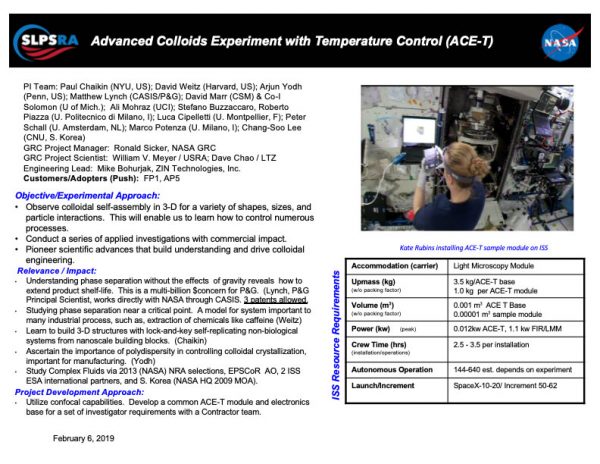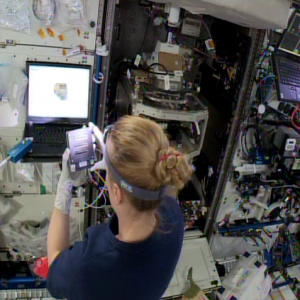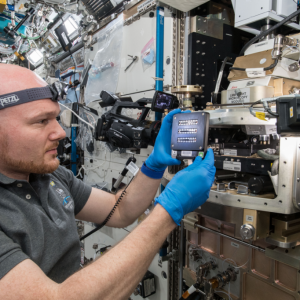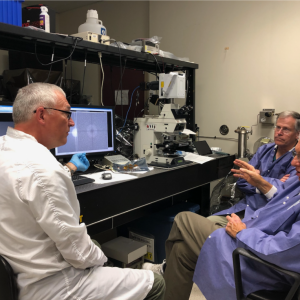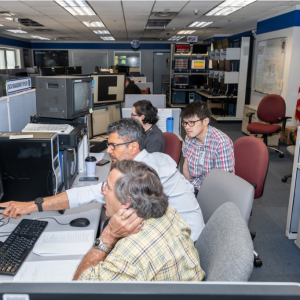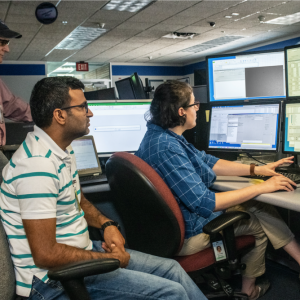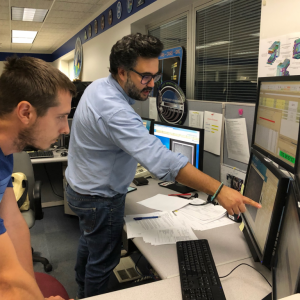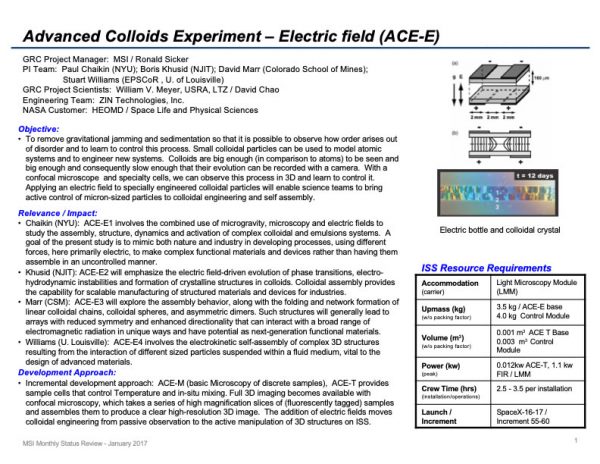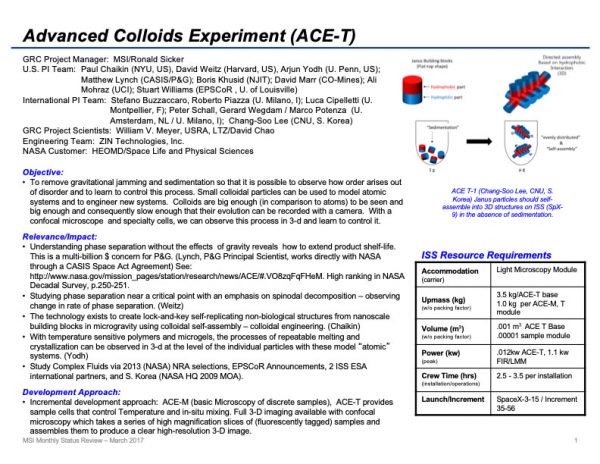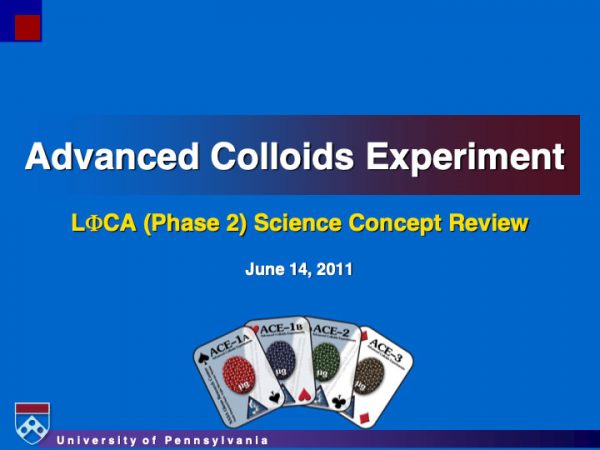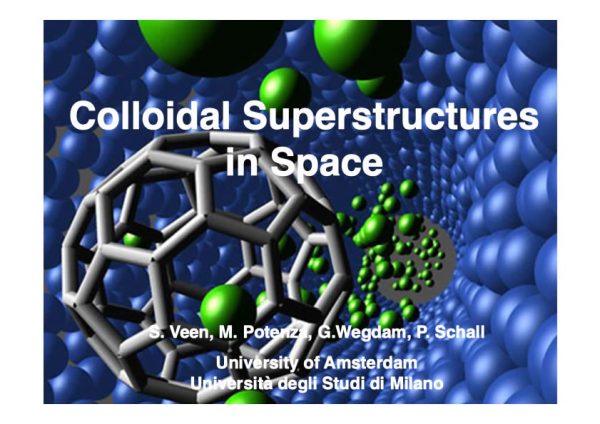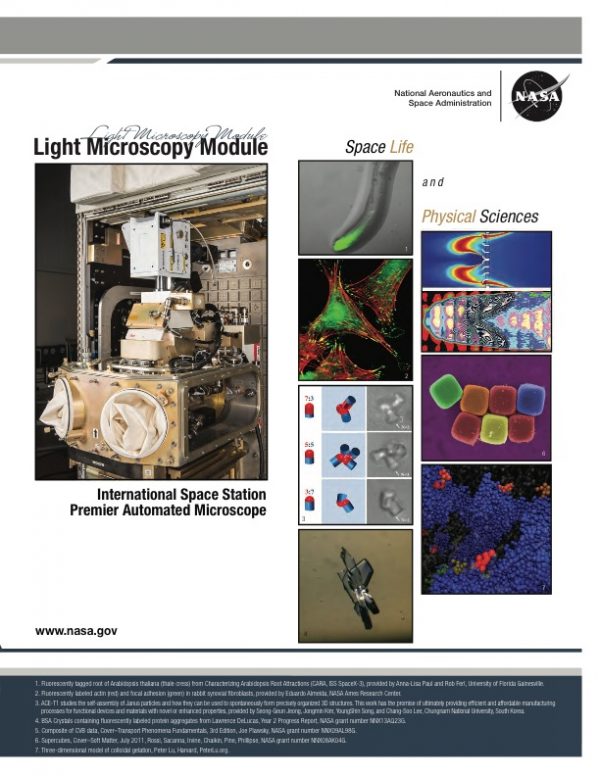ACE
Advanced Colloids Experiments (ACE)
To remove gravitational jamming and sedimentation so that it is possible to observe how order arises out of disorder and to learn to control this process. Small colloidal particles can be used to model atomic systems and to engineer new systems. Colloids are big enough (in comparison to atoms) to be seen and big enough and consequently slow enough that their evolution can be recorded with a camera. With a confocal microscope, templates and grids, we can observe this process in 3-d and learn to control it.
Recent Videos
|
|
|
|
Recent Updates
Start of Advanced Colloids Experiment with Temperature control – Two (ACE-T2-3) in FIR/LMM
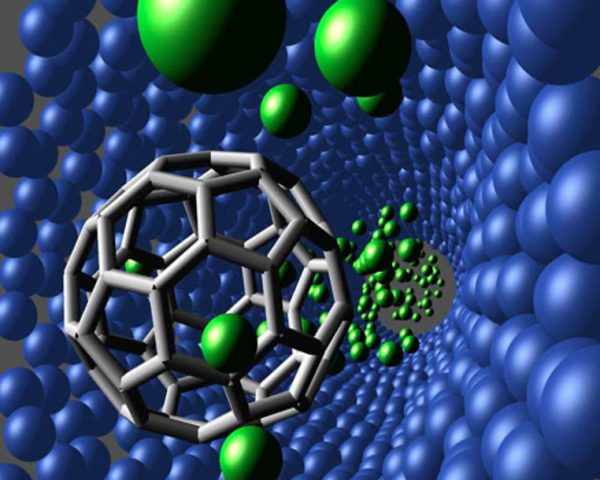
The Advanced Colloids Experiment (with Temperature control) – ACE-T2-3 began Mission Operations on the International Space Station (ISS) April 27 and is planned to operate through May 27, 2021. It should deliver an increased understanding of how to use temperature fluctuations to self-assemble superstructures from micron-sized round particles containing surface patches. The experiment is conducted in the GRC Managed Fluid Integrated Rack and Light Microscopy Module. The Principal Investigator for ACE-T2-3 is Professor Peter Schall from the University of Amsterdam. The PI reports: “The experiments started up successfully: the particles are well dispersed, can clearly be imaged, and respond to temperature as expected. We already saw individual particles clustering and forming structures, in three dimensions, which we are not able to observe on earth. The currently performed run should yield the first interesting science, going beyond ground-based experiments.”
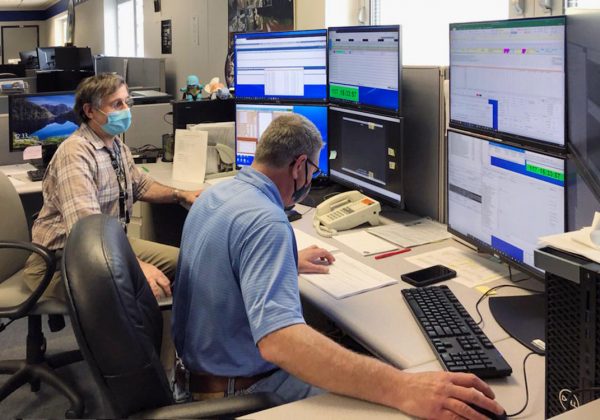 |
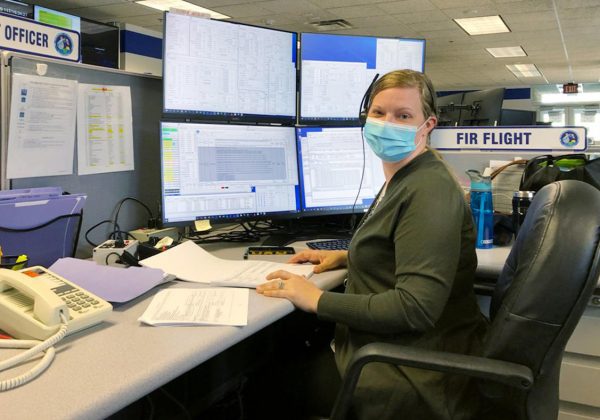 |
Latest article about FIR/LMM/ACE
International Space Station Research on Tiny Colloid Particles Yields Big Results
Achievements for the week ending:
Completion of Advanced Colloids Experiment-Four (ACE-T4) on the International Space Station.
Advanced Colloids Experiment with Temperature Control-Four (ACE-T4-2), Start of Final Week of Operations on International Space Station
Advanced Colloids Experiment with Temperature control Four (ACE-T4-2), Second Experiment Module on International Space Station
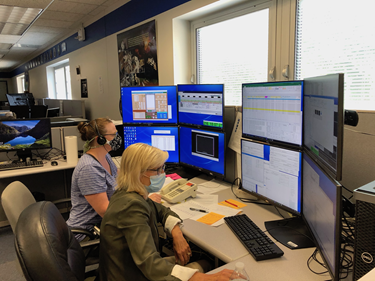
The second module for ACE-T4-2 completed the first of three samples on August 5, 2020. The remaining two samples will be operated over the next 3-4 weeks at the Glenn Research Center (GRC) Telescience Support Center. The test matrix has samples of different concentrations and dopants that react at different temperatures. As the temperature (stress) increases on the gel structure more fluid gets between the structures and finally breaks the gel apart. Certain additives (Dopants) can slow this failure mechanism. The samples are observed in real time using the GRC managed Light Microscopy Module and 3D confocal scanning camera. The understanding of the performance (and ultimate failure) of gel structures effects everyday consumer products and new technologies such as 3D printing. In space stresses on these gel structures can be observed on a timescale thousands of times longer than on earth.
Thermal Thrashing of a Gel:
The Advanced Colloids Experiment (ACE-T4) began testing aboard the ISS to study how gels evolve and break in response to internal stresses generated by temperature changes. Gels are used in situations that arise every day, i.e., in everyday products from the drugstore, as well as in more complex instrumentation such as 3D-printers. This work will provide information about the microstructure of gels leading to “tougher” gels.
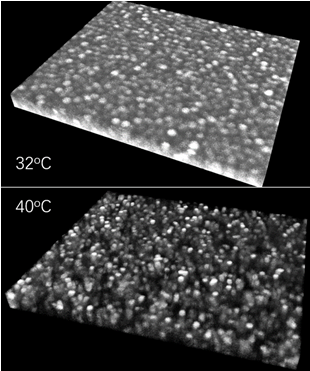 Colloids are a homogeneous noncrystalline substance consisting of large molecules or ultramicroscopic particles of one substance dispersed through a second substance. Colloids include gels, sols, and emulsions; the particles cannot be separated out by ordinary filtering or centrifuging.
Colloids are a homogeneous noncrystalline substance consisting of large molecules or ultramicroscopic particles of one substance dispersed through a second substance. Colloids include gels, sols, and emulsions; the particles cannot be separated out by ordinary filtering or centrifuging.
The ACE experiments are conducted in the Light Microscopy Module (LMM) in the Fluids Integrated Rack (FIR). The LMM is a modified commercial, highly flexible, light imaging microscope facility with the capability of remotely acquiring and downloading digital images.
The ACE-T4 experiment has six samples with each containing about 20 microliters of water and particles. Each sample contained a different mixture ratio of thermo-responsive poly(N -isopropylacrylamide) (pNIPA) particles and polystyrene particles encapsulated within pNIPA sheaths. These particles shrink with as temperature increases and the gel becomes more porous. Samples are cycled between the ISS ambient temperatures and 40°C to relieve stresses upon heating or generate stresses upon cooling.
Over the past week, the microstructure of the colloidal gel in Capillary 1 was studied as a function of internal stress imposed by the sample temperature. Although these data will require extensive image analysis, preliminary observations clearly show that the gels become more porous with increased internal stress. Further studies of this sample (Capillary 1) are also planned. Specifically, the temporal response of the gel microstructure to rapid changes of internal stress will be investigated. Three samples were previously studied. Baseline images of the remaining were also acquired.
Professor Arjun Yodh from the University of Pennsylvania is the principal investigator
Microgravity on International Space Station (ISS) Provides a Unique Opportunity to Study the Microstructure and Internal Stress Response of Dense Gels
The Advanced Colloids Experiment with Temperature control Four (ACE-T4-1) recently completed 5weeks of operations on IS Sin the Glenn Research Center managed Fluid Integrated Rack and Light Microscopy Module. The temperature-sensitive pNIPAM Microgel spheres have been engineered for this experiment. They shrink with an increase in temperature, at 32 degrees C (top), the gel has a larger density (dense gel), and at 40 degrees C (bottom),the gel becomes more porous. This effect is due to the volume fraction variation of the thermo-sensitive hydrogel particles and a concomitant variation of internal stress. We are using this unique opportunity to study the microstructure and internal stress response of dense gels. Dense gel-like materials are increasingly used to manufacture structures by 3D printing. Knowledge from our experiment should enable us to understand the plasticity or brittleness of gels, which is important for materials processing. Comparison of the microstructure in samples with different boundary conditions (constant/non-constant volume) will provide insight about stress relaxation and embrittlement in the absence of gravitational forces, which one can only study in microgravity. This experiment is also giving us new insight into glasses, a topic for another highlight.
Advanced Colloids Experiment with Temperature control (ACE-TR)[Ellipsoids] –Acquiring Ground-Based Data in Preparation for Flight
The ACE-TR [Ellipsoids] Flight Project has acquired some ground-based data in preparation for an upcoming microgravity flight experiment on the International Space Station. Image processing on the acquired data from the concentrated ellipsoidal particles compared images captured with 63x (magnification) airobjectivesandthe100x oil immersion objectives. The analyses are being performed at New Jersey Institute of Technology (Khusid, et al.)and New York University (NYU)(Hollingsworth and Chaikin). The images are low-contrast and are being used to refine the software that will provide results that will help guide the flight experiment –enabling contour measurements to give particle position, angle, and axis length (aspect ratio). Scanning Electron Microscope images provided by NYU are also being used to optimize and determine the best capabilities of the fitting algorithms being developed.
|
|
ACE-H
ACE-H-1
(Advanced Colloids Experiment-Heated-1)
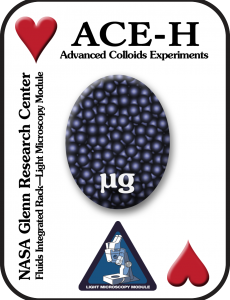 The Advanced Colloids Experiment-Heated-1 (ACE-H-1) experiment examines densely packed microscopic spheres, or colloidal mixtures, to study their transition from ordered crystals into disordered glass. The particles are fluorescent and change size in different temperatures, so scientists are able to see how they move and change forms as they are heated and cooled. Studying particle interactions without the influence of gravity improves the ability of scientists to understand how increasing disorder in a crystal material affects its freezing, melting, aging and structural integrity.
The Advanced Colloids Experiment-Heated-1 (ACE-H-1) experiment examines densely packed microscopic spheres, or colloidal mixtures, to study their transition from ordered crystals into disordered glass. The particles are fluorescent and change size in different temperatures, so scientists are able to see how they move and change forms as they are heated and cooled. Studying particle interactions without the influence of gravity improves the ability of scientists to understand how increasing disorder in a crystal material affects its freezing, melting, aging and structural integrity.
Principal Investigator(s)
-
-
- Arjun Yodh, Ph.D., University of Pennsylvania, Philadelphia, Pennsylvania, United States
-
Co-Investigator(s)/Collaborator(s)
-
-
- Mathew Lohr, University of Pennsylvania, Philadelphia, Pennsylvania, United States
- Matthew Gratale, Ph.D., University of Pennsylvania, Philadelphia, Pennsylvania, United States
-
ACE-H-2
(Advanced Colloids Experiment-Heated-2)
Small particles suspended in a mixture, known as colloids, can combine to form complex structures and be used in new advanced materials. Colloids are found in a wide range of foods and consumer products, but they can also include particles with unique surface chemistry or electrostatic properties that allow them bind to each other in various ways. The Advanced Colloids Experiment-H-2 (ACE-H-2) investigation studies a technique called nanoparticle haloing, which stabilizes colloidal mixtures and may be important for designing advanced materials for use in medicine, imaging and other fields.
Principal Investigator(s)
-
-
- Stuart K. Williams, Ph.D., The University of Arizona, Tucson, Arizona, United States
- Suzanne Smith, Ph.D., University of Kentucky, Lexington, Kentucky, United States
-
Co-Investigator(s)/Collaborator(s)
-
-
- Gerold Willing, Ph.D., University of Louisville, Louisville, Kentucky, United States
- Hemali Rathnayake, Ph.D., Western Kentucky University, Bowling Green, Kentucky, United States
-
ACE-M
ACE-M-1
(Advanced Colloids Experiment-Microscopy-1)
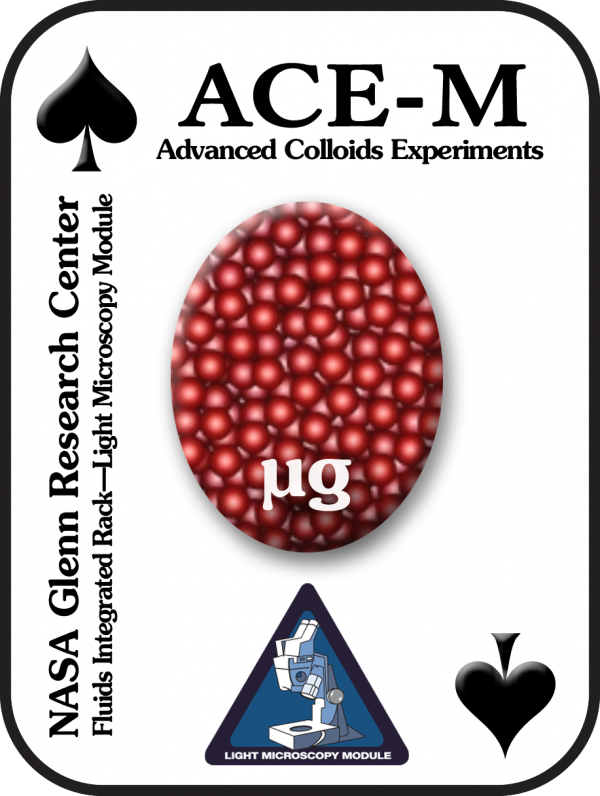 Advanced Colloids Experiment-Microscopy-1 (ACE-M-1) studies the behavior of microscopic particles in gels and creams. Many consumer products are colloidal mixtures with stabilizers added to make them last longer. But eventually, particles still clump together and sink to the bottom in a process known as coarsening which can spoil a product. The International Space Station is an ideal location to study the physics of coarsening which could lead to manufacturing longer lasting products.
Advanced Colloids Experiment-Microscopy-1 (ACE-M-1) studies the behavior of microscopic particles in gels and creams. Many consumer products are colloidal mixtures with stabilizers added to make them last longer. But eventually, particles still clump together and sink to the bottom in a process known as coarsening which can spoil a product. The International Space Station is an ideal location to study the physics of coarsening which could lead to manufacturing longer lasting products.
Principal Investigator(s)
-
-
- Matthew Lynch, Ph.D., Procter and Gamble, West Chester, Ohio, United States
- Thomas Kodger, Harvard University, Cambridge, Massachusetts, United States
-
ACE-M-2
(Advanced Colloids Experiment-Microscopy-2)
Sometimes it’s hard to tell a gas from a liquid. Advanced Colloids Experiment-Microscopy-2 (ACE-M-2) observes the microscopic behavior of liquids and gases separating from each other. The investigation examines the behavior of model (colloid rich) liquids and model (colloid poor) gases near the critical point, or the point at which there is no distinct boundary between the two phases. ACE-M-2 uses a new microscope to record micro-scale events on short time scales, while previous experiments observed large-scale behavior over many weeks. Liquids and gases of the same material usually have different densities, so they would behave differently under the influence of gravity, making the microgravity environment of the International Space Station ideal for these experiments.
Principal Investigator(s)
-
-
- David A. Weitz, Ph.D., Harvard University, Cambridge, Massachusetts, United States
-
Co-Investigator(s)/Collaborator(s)
-
-
- Peter J Lu, Ph.D., Harvard University, Cambridge, Massachusetts, United States
-
ACE-M-3
(Advanced Colloids Experiment-Microscopy-3)
The ACE-M-3 experiment involves the design and assembly of complex three-dimensional structures from small particles suspended within a fluid medium. These so-called “self-assembled colloidal structures”, are vital to the design of advanced optical materials. In the microgravity environment, insight will be provided into the relation between particle shape, crystal symmetry, and structure: a fundamental issue in condensed matter science.
Principal Investigator(s)
-
-
- Paul M. Chaikin, Ph.D., New York University, New York City, New York, United States
-
Co-Investigator(s)/Collaborator(s)
-
-
- Stefano Sacanna, Ph.D., New York University, New York, New York, United States
- Andrew D. Hollingsworth, Ph.D., New York University, New York City, New York, United States
-
ACE-T
ACE-T-1
(Advanced Colloids Experiment-Temperature control-1)
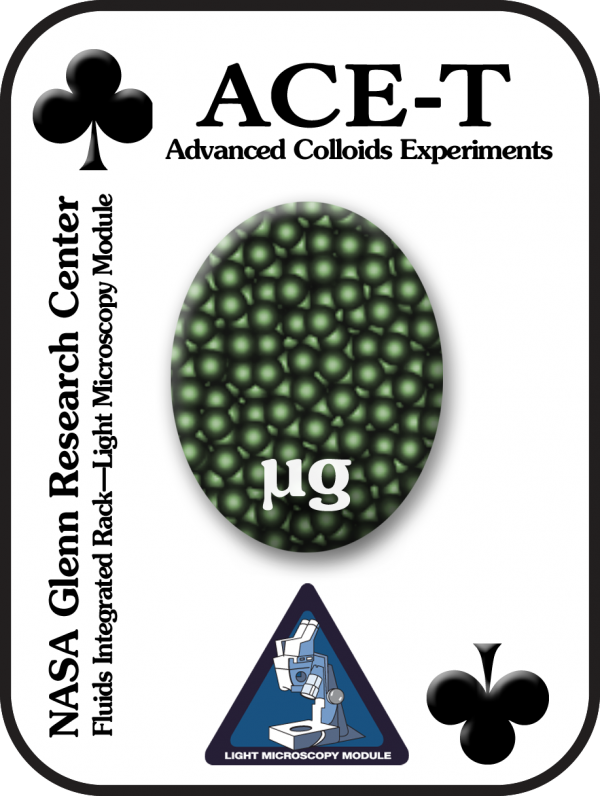 Advanced Colloids Experiment-Temperature control-1 (ACE-T-1) studies tiny suspended particles which have been designed by scientists to connect themselves in a specific way to form organized structures within water. Materials having complex structures and unique properties potentially can be made with more knowledge of how these particles are joined together and the conditions which control their behaviors. The particular type of particles used in ACE-T-1 are referred to as Janus particles, named after the two faced Roman god Janus because these particles may be said to have “two faces” since they possess two distinct types of properties. The Janus particles being studied have one half of their surface composed of hydrophilic groups (which interact with water) and the other half of hydrophobic groups (which are repelled from water). The microgravity environment on the International Space Station (ISS) provides researchers insight into the fundamental physics of micro particle self-assembly and the kinds of colloidal structures that are possible to fabricate. This in turn helps manufacturers on Earth in choosing which high-value material is worth investigating.
Advanced Colloids Experiment-Temperature control-1 (ACE-T-1) studies tiny suspended particles which have been designed by scientists to connect themselves in a specific way to form organized structures within water. Materials having complex structures and unique properties potentially can be made with more knowledge of how these particles are joined together and the conditions which control their behaviors. The particular type of particles used in ACE-T-1 are referred to as Janus particles, named after the two faced Roman god Janus because these particles may be said to have “two faces” since they possess two distinct types of properties. The Janus particles being studied have one half of their surface composed of hydrophilic groups (which interact with water) and the other half of hydrophobic groups (which are repelled from water). The microgravity environment on the International Space Station (ISS) provides researchers insight into the fundamental physics of micro particle self-assembly and the kinds of colloidal structures that are possible to fabricate. This in turn helps manufacturers on Earth in choosing which high-value material is worth investigating.
Principal Investigator(s)
-
-
- Chang-Soo Lee, Ph.D., Chungnam National University, Daejeon, South Korea
-
ACE-T-2
(Advanced Colloids Experiment-Temperature-2)
The Advanced Colloids Experiment-Temperature-2 (ACE-T-2) experiment looks at the assembly of complex structures from micron-scale colloidal particles interacting via tunable attractive interactions. The samples contain suspensions of trifluoroethyl methacrylate (FEMA) colloidal particles (10%vol) of type A and B in binary solvents composed of water (H2O, 68%mass) and lutidine (32%mass), that upon nearing the critical solvent temperature (Tc~32°C) give rise to critical Casimir interactions between the particles. Regulating the temperature enables control of the particle interactions, which for these mixtures of particles A and B are different, leading to the growth of complex structures, and provide a better understanding of how complex interactions lead to complex structures, and to understand the dynamics of growth of these structures.
Principal Investigator(s)
-
-
- Peter Schall, Ph.D., University of Amsterdam, Institute of Physics, Amsterdam, Netherlands
-
Co-Investigator(s)/Collaborator(s)
-
-
- Gerard Wegdam, Ph.D., University of Amsterdam, Institute of Physics, Amsterdam, Netherlands
- Simon Stuij, University of Amsterdam, Institute of Physics, Amsterdam, Netherlands
- Piet Swinkels, University of Amsterdam, Institute of Physics, Amsterdam, Netherlands
- Marco A. C. Potenza, Ph.D., University of Milan, Milan, Italy
-
ACE-T-4
(Advanced Colloids Experiment-Temperature-4)
Introducing disorder to a crystalline system in a controlled way can form glass. Advanced Colloids Experiment-Temperature-4 (ACE-T-4) examines the transition of an ordered crystal to a disordered glass to determine how increasing disorder affects structural and dynamic properties. The investigation controls disorder by controlling temperature in a series of samples and observes the microscopic transition in three dimensions.
Principal Investigator(s)
-
-
- Arjun Yodh, Ph.D., University of Pennsylvania, Philadelphia, Pennsylvania, United States
-
Co-Investigator(s)/Collaborator(s)
-
-
- Chandan Mishra Kumar, University of Pennsylvania, Philadelphia, Pennsylvania, United States
- Xiaoguang Ma, University of Pennsylvania, Philadelphia, Pennsylvania, United States
-
ACE-T-5
(Advanced Colloids Experiment-Temperature-5)
Advanced Colloids Experiment-Temperature-5 (ACE-T-5) examines the physical and chemical characteristics of a new class of soft materials, bicontinuous interfacially jammed emulsion gels, or bijels. Bijels have a unique structure of two liquid phases separated by a layer of small particles or colloids, which has significant potential for the design and synthesis of composite materials. A more thorough understanding of the factors that influence their mechanical stability and processing will advance this potential.
|
|
Principal Investigator(s)
-
-
- Ali Mohraz, Ph.D., University of California, Irvine, Irvine, California, United States
-
ACE-T-6
(Advanced Colloids Experiment-Temperature-6)
Colloids are suspensions of microscopic particles in a liquid, and they are found in products ranging from milk to fabric softener. Consumer products often use colloidal gels to distribute specialized ingredients, for instance droplets that soften fabrics, but the gels must serve two opposite purposes: they have to disperse the active ingredient so it can work, yet maintain an even distribution so the product does not spoil. Advanced Colloids Experiment-Temperature-6 (ACE-T-6) studies the microscopic behavior of colloids in gels and creams, providing new insight into fundamental interactions that can improve product shelf life.
Principal Investigator(s)
-
-
- Matthew Lynch, Ph.D., Procter and Gamble, West Chester, Ohio, United States
-
Co-Investigator(s)/Collaborator(s)
-
-
- Thomas Kodger, Harvard University, Cambridge, Massachusetts, United States
-
ACE-T-7
(Advanced Colloids Experiment-Temperature-7)
The Advanced Colloids Experiment-Temperature-7 (ACE-T-7) experiment involves the design and assembly of complex three-dimensional structures from small particles suspended within a fluid medium. These so-called “self-assembled colloidal structures”, are vital to the design of advanced optical materials and active devices. In the microgravity environment, insight is provided into the relation between particle shape and interparticle interactions on assembly structure and dynamics: fundamental issues in condensed matter science.
Principal Investigator(s)
-
-
- Paul M. Chaikin, Ph.D., New York University, New York City, New York, United States
-
Co-Investigator(s)/Collaborator(s)
-
-
- Andrew D. Hollingsworth, Ph.D., New York University, New York City, New York, United States
- Stefano Sacanna, Ph.D., New York University, New York, New York, United States
-
ACE-T-9
(Advanced Imaging, Folding, and Assembly of Colloidal Molecules)
The Advanced Imaging, Folding, and Assembly of Colloidal Molecules (ACE-T-9) experiment involves the imaging, folding, and assembly of complex colloidal molecules within a fluid medium. This set of experiments not only prepares for future colloidal studies, but also provides insight into the relationship between particle shape, colloidal interaction, and structure. These so-called “colloidal molecules” are vital to the design of new and more stable product mixtures.
Principal Investigator(s)
-
-
- David Marr, Ph.D., Colorado School of Mines, Golden, Colorado, United States
-
Co-Investigator(s)/Collaborator(s)
-
-
- Ning Wu, Ph.D., Colorado School of Mines, Golden, Colorado, United States
- Michael Solomon, Ph.D., University of Michigan, Ann Arbor, Michigan, United States
-
ACE-T-10
(Advanced Colloidal Experiment-Temperature-10)
Advanced Colloids Experiment-Temperature-10 (ACE-T-10) investigates the growth kinetics, microscopic dynamics, and restructuring processes in ordered and disordered structures such as colloidal crystals, glasses and gels. The investigation studies crystal nucleation in colloidal fluids, the origin of ageing in glasses and gels, as well as the heterogeneous nature of the microscopic dynamics in these structures. The study must be conducted in microgravity, as gravitational stresses affect the structure and growth of these solids from colloids.
Principal Investigator(s)
-
-
- Roberto Piazza, Ph.D., Politecnico di Milano, Milano, Italy
-
Co-Investigator(s)/Collaborator(s)
-
-
- Luca Cipelletti, Ph.D., Universite Monpellier II, Montpellier, France
- Stefano Buzzaccaro, Ph.D., Politecnico di Milano, Milano, Italy
-
ACE-T-11
(Advanced Colloids Experiment-Temperature Control and Gradient Sample-11)
Advanced Colloids Experiment-Temperature Control and Gradient Sample-11 (ACE-T-11) involves the design and assembly of complex three-dimensional (3D) structures from colloids, or small particles suspended within a fluid medium, and control of particle density and phase behavior. Such structures are vital to the design of advanced optical materials and important for 3D printing and additive manufacturing. Assembling structures in microgravity provides insight into the relation between particle shape, crystal symmetry, density, and other fundamental factors.
Principal Investigator(s)
-
-
- Boris Khusid, Ph.D., New Jersey Institute of Technology, Newark, New Jersey, United States
-
Co-Investigator(s)/Collaborator(s)
-
-
- Paul M. Chaikin, Ph.D., New York University, New York City, New York, United States
- Andrew D. Hollingsworth, Ph.D., New York University, New York City, New York, United States
-
ACE-T-12
(Advanced Colloids Experiment-Nanoparticle Haloing)
Advanced Colloids Experiment-Nanoparticle Haloing (ACE-T-12) involves design and assembly of complex three-dimensional (3D) structures from colloids, or particles of different sizes suspended in a fluid. It employs a recently discovered technique, Nanoparticle Haloing (NPH), which uses highly charged nanoparticles to stabilize much larger, non-charged particles. Allowing these structures to form in microgravity provides insight into the relationship between shape, surface charge, and concentration of particles and particle interactions.
Principal Investigator(s)
-
-
- Stuart J. Williams, Ph.D., University of Louisville, Louisville, Kentucky, United States
- Suzanne Smith, Ph.D., University of Kentucky, Lexington, Kentucky, United States
-
Co-Investigator(s)/Collaborator(s)
-
-
- Gerold Willing, Ph.D., University of Louisville, Louisville, Kentucky, United States
-
Image Gallery
Videos
|
|
|
|
Related Documents
Publications
- ME Leunissen, A van Blaaderen , AD Hollingsworth, MT Sullivan, PM Chaikin, “Electrostatics at the oil-water interface, stability, and order in emulsions and colloids,” PNAS 104, 2585-2590, (2007).
- Chaikin, Paul “Reference Frame,” Physics Today, June 2007 p8.
- Kun Zhao and David Huse, Christopher Harrison, W. B. Russel, P. M. Chaikin, “Nematic and Almost Tetratic Phases of Colloidal Rectangles” to be published in Phys. Rev. E.
- P. M., Chaikin, Donev, Aleksandar, Man, Weining, Stillinger, Frank H., Torquato, Salvatore, “Some observations on the random packing of hard ellipsoids,” INDUSTRIAL & ENGINEERING CHEMISTRY RESEARCH 45, 6960-6965 (2006).
- M. T. Sullivan, K. Zhao, A. D. Hollingsworth, R. H. Austin, W. B. Russel, and P. M. Chaikin, “An Electric Bottle for Colloids,” Phys. Rev. Lett. 96, 015703 (2006).
- Weining Man, Mischa Megens, Paul J. Steinhardt, P. M. Chaikin, “Experimental measurement of the photonic properties of icosahedral quasicrystals,” Nature 436, 993-996 (2005).
- Valignat MP, Theodoly O, Crocker JC, Russel WB, Chaikin PM “Reversible self-assembly and directed assembly of DNA-linked micrometer-sized colloids,” PNAS 102, 4225 ( 2005).
- “Experiments on Random Packings of Ellipsoids,” Man WN, Donev A, Stillinger FH, Sullivan MT, Russel WB, Heeger D, Inati S, Torquato S, Chaikin PM Source: Phys. Rev. Lett. 94, 198001 (2005).
- Aleksandar Donev, Ibrahim Cisse, David Sachs, Evan A. Variano, Frank H. Stillinger, Robert Connelly, Salvatore Torquato, and P. M. Chaikin, “Improving the Density of Jammed Disordered Packings Using Ellipsoids,” Science 303, 990 (2004).
- Aleksandar Donev, Frank H. Stillinger, P. M. Chaikin, and Salvatore Torquato, “Unusually
dense Crystal Packings of Ellipsoids,” Phys. Rev. Lett. 92, 255506-1 (2004).
Contact Information
Principal Investigator Team:
Dr. Paul Chaikin, New York University, New York City, New York, United States
Dr. David Weitz, Harvard University, Cambridge, Massachusetts, United States
Dr. Arjun Yodh, University of Pennsylvania, Philadelphia, Pennsylvania, United States
Dr. Matthew Lynch, Procter and Gamble, West Chester, Ohio, United States
Dr. David Marr, Colorado School of Mines, Golden, Colorado, United States
Co-Investigators:
Dr. Michael Solomon, University of Michigan, Ann Arbor, Michigan, United States
Dr. Ali Mohraz, University of California, Irvine, Irvine, California, United States
Dr. Stefano Buzzaccaro, Politecnico di Milano, Milano, Italy
Dr. Roberto Piazza, Politecnico di Milano, Milano, Italy
Dr. Luca Cipelletti, Universite Monpellier II, Montpellier, France
Dr. Peter Schall, University of Amsterdam, Institute of Physics, Amsterdam, Netherlands
Dr. Marco Potenza, University of Milan, Milan, Italy
Dr. Chang-Soo Lee, Chungnam National University, Daejeon, South Korea
Project Manager: Ronald Sicker, NASA GRC
Project Scientist: William V. Meyer/USRA; Dave Chao/LTZ
Engineering Lead: Mike Bohurjak, ZIN Technologies, Inc.


